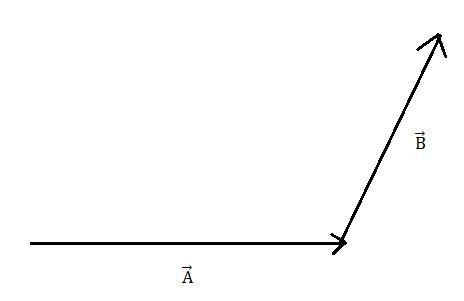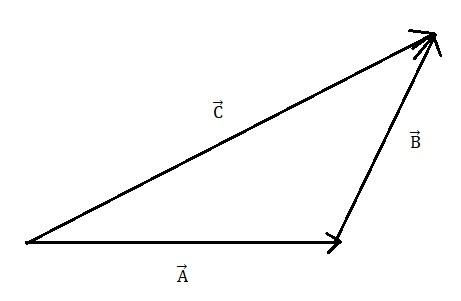
Assertion: Minimum number of non-equal Vectors in a plane required to give zero resultant is three.
Reason: If
\[\begin{array}{*{20}{c}}
{\overrightarrow A + \overrightarrow B + \overrightarrow C }& = &0
\end{array}\], then they must be lying in one plane
A) If both assertion and reason are true and the reason is the correct explanation of assertion.
B) If both assertion and reason are true but reason is not the correct explanation of assertion.
C) If assertion is true but reason is false.
D) If both assertion and reason are false.
Answer
215.7k+ views
Hint:
In this question, we have given that the three vectors are required to get the resultant zero. Therefore, we will check this condition according to the Polygon Law. With the help of the polygon law, we will also check the second statement. And then we will choose the correct answer from the given option.
Complete step by step solution:
According to the polygon law, we will check the first statement. Therefore, the polygon law states that If the two or more coplanar, non-collinear, concurrent vectors are represented by the side of the polygon in the same direction, then there must be a closing vector and that should be in the opposite direction. This closing vector is also known as the resultant.
Let us assume that there are two vectors\[\overrightarrow A \],\[\overrightarrow B \]respectively that are shown below the figure,

Figure 1
Now, to get the resultant of these two vectors, we will add an equal and opposite vector \[\overrightarrow C \]. Therefore, we will get a triangle as shown below the figure,

Figure 2
Now the equation of the vector addition will be,
\[\begin{array}{*{20}{c}}
{ \Rightarrow \overrightarrow A + \overrightarrow B }& = &{ - \overrightarrow C }
\end{array}\]
\[\begin{array}{*{20}{c}}
{ \Rightarrow \overrightarrow A + \overrightarrow B + \overrightarrow C }& = &0
\end{array}\]
Therefore, from the above explanation, we can conclude that there must be a minimum of three vectors to get the resultant zero.
Now the statement- I Is true.
And as shown in the figure in which there is a triangle, All the vectors are in the same plane.
Therefore, the statement- II is also true.
But the statement- II is not the correct example of the statement- I. Because statement- I is explained by the polygon law, statement- II explains the triangle law of the vector addition.
Therefore, the correct option is B.
Note:
In this question, we will have to check the condition using the Polygon law. Therefore, the point is to keep in mind that the resultant vector or closing vector of the polygon must be in the opposite direction.
In this question, we have given that the three vectors are required to get the resultant zero. Therefore, we will check this condition according to the Polygon Law. With the help of the polygon law, we will also check the second statement. And then we will choose the correct answer from the given option.
Complete step by step solution:
According to the polygon law, we will check the first statement. Therefore, the polygon law states that If the two or more coplanar, non-collinear, concurrent vectors are represented by the side of the polygon in the same direction, then there must be a closing vector and that should be in the opposite direction. This closing vector is also known as the resultant.
Let us assume that there are two vectors\[\overrightarrow A \],\[\overrightarrow B \]respectively that are shown below the figure,

Figure 1
Now, to get the resultant of these two vectors, we will add an equal and opposite vector \[\overrightarrow C \]. Therefore, we will get a triangle as shown below the figure,

Figure 2
Now the equation of the vector addition will be,
\[\begin{array}{*{20}{c}}
{ \Rightarrow \overrightarrow A + \overrightarrow B }& = &{ - \overrightarrow C }
\end{array}\]
\[\begin{array}{*{20}{c}}
{ \Rightarrow \overrightarrow A + \overrightarrow B + \overrightarrow C }& = &0
\end{array}\]
Therefore, from the above explanation, we can conclude that there must be a minimum of three vectors to get the resultant zero.
Now the statement- I Is true.
And as shown in the figure in which there is a triangle, All the vectors are in the same plane.
Therefore, the statement- II is also true.
But the statement- II is not the correct example of the statement- I. Because statement- I is explained by the polygon law, statement- II explains the triangle law of the vector addition.
Therefore, the correct option is B.
Note:
In this question, we will have to check the condition using the Polygon law. Therefore, the point is to keep in mind that the resultant vector or closing vector of the polygon must be in the opposite direction.
Recently Updated Pages
Circuit Switching vs Packet Switching: Key Differences Explained

Mass vs Weight: Key Differences Explained for Students

Alpha, Beta, and Gamma Decay Explained

Alpha Particle Scattering and Rutherford Model Explained

Angular Momentum of a Rotating Body: Definition & Formula

Apparent Frequency Explained: Formula, Uses & Examples

Trending doubts
JEE Main 2026: Application Form Open, Exam Dates, Syllabus, Eligibility & Question Papers

JEE Main Correction Window 2026 Session 1 Dates Announced - Edit Form Details, Dates and Link

Derivation of Equation of Trajectory Explained for Students

Hybridisation in Chemistry – Concept, Types & Applications

Understanding the Angle of Deviation in a Prism

Understanding Collisions: Types and Examples for Students

Other Pages
JEE Advanced Marks vs Ranks 2025: Understanding Category-wise Qualifying Marks and Previous Year Cut-offs

Units And Measurements Class 11 Physics Chapter 1 CBSE Notes - 2025-26

NCERT Solutions For Class 11 Physics Chapter 8 Mechanical Properties Of Solids

Motion in a Straight Line Class 11 Physics Chapter 2 CBSE Notes - 2025-26

NCERT Solutions for Class 11 Physics Chapter 7 Gravitation 2025-26

How to Convert a Galvanometer into an Ammeter or Voltmeter




